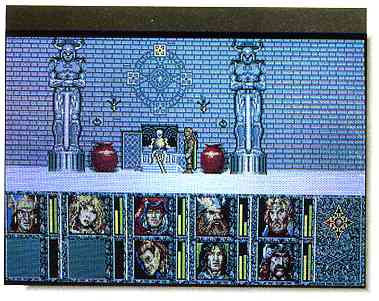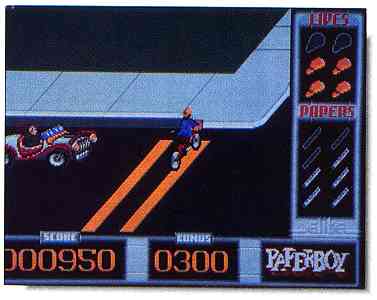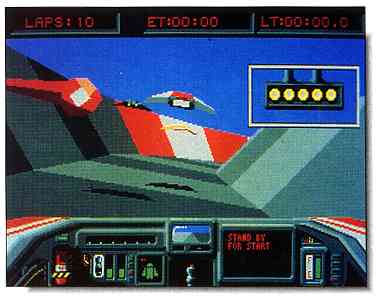MEDIEVAL
FIRE, MODERN
PAPER
AND FUTURISTIC POWER
In which Bernstein gets burned, and
Perez burns rubber.
DRAGONS OF FLAME
REVIEWED BY HARVEY BERNSTEIN
A sequel to Heroes of the Lance, Dragons of Flame is Strategic Simulations' second attempt to translate the wildly popular Dungeons & Dragons Dragonlance module to a computer role-playing game. The result is more of an arcade hack-n-slash with fantasy elements than an intricate role-playing adventure.
When Last We Met
Dragons of Flame picks up where Heroes of the Lance left off. Having
previously recovered the Disks of Mishakal, your goal is to gain entrance
into the fortress of the evil Draconians, recover the legendary sword,
Wyrmslayer, and free the slaves held in the dungeon. You control the same
original party of eight characters, with the character in the lead as the
active party member. This active member's image on the screen represents
the entire party; you control only his or her actions in battle.
In the deepest levels of the fortress, you encounter a never-ending parade of trolls, griffins, goblins and dragons. Your active character can either engage in close combat or fire any weapons (slings, bows or spears) with which he or she is equipped. Certain enemies, however, can only be defeated if the proper character is active. All movement and fighting is done with the joystick. Your magician's spells are accessed through a series of menus, which I found to be an awkward and interrupting task in the middle of battle.
As you progress in the game, you discover better weapons, potions and treasures, but other than looking for hidden doors and traps, there are no intricate puzzles to solve. The interaction with the creatures you encounter is pretty much limited to combat, although you do, occasionally, run into townspeople who offer you clues and join your party (there are two spaces for such additions).
Problems and Recommendations
The Dragons of Flame characters don't grow with experience and their
attributes remain fixed, which leads me to my biggest problem with the
game: the lack of feeling in absolute control over an entire party of real
characters, a hallmark of any good role-playing game.
Graphics and animation are well done - up to ST standards. Each of the characters and enemies are rendered with distinctive detail. The similarity of the different rooms and the obscure pathways, however, makes mapping the game rather difficult. But the background scrolls smoothly as you travel. Game disks are not copy protected but use the manual-based, keyword system.
All in all, Dragons of Flame is a decent enough time - killer for those who like an arcade game with a fantasy subtext. For those of us weaned on Ultima and Dungeon Master, however, it falls one step short of the mark.

SSI's Dragons of Flame.
PAPERBOY
REVIEWED BY GREG PEREZ
The job of delivering newspapers to dozens of waking customers isn't always easy: you have avoid the most treacherous of suburban obstacles on a BMX bike, without even a mumble of thanks from sleepy recipients. This is the saga of our unsung hero. Paperboy from Mindscape gives you a first-hand experience of the trials and tribulations of your friendly neighborhood carrier.
Monday, Monday
Your route begins early Monday morning. The goal is to deliver your
pack of papers to your loyal customers who wearily await the morning edition.
At the beginning of the game, your customers are displayed on a map that
shows the Street to which you have to deliver. Depending on the level of
difficulty, your street may have differing numbers of customers. Easy Street
starts you off with just a few simple deliveries, while Middle Road gives
even the tried-and-true delivery boy a rough time and Hard Way may force
you to an early retirement if you aren't careful! The customers' homes
are colored yellow, while houses of those who refuse your services are
black. Depending on how you handle your route, you gain or lose customers.
The adventure begins as you pedal your way down the street. Don't be too cautious: speed may be your only way to dodge oncoming traffic or the neighbor's rabid poodle! Push the joystick up or down to control the rate of pedaling; the fire-button flings newspapers. To score points (and keep subscribers) you chuck a paper to each mailbox or doorstep. But, be careful. If you break anything on a subscriber's house, you can say bye-bye to their subscription. Of course, if you really have the urge to destroy something, you can get bonus points for bombarding any non-subscribers' houses. Once you run out of ammo, you can scoop a pack of papers that waits along the sidewalks.
Arcade Fun
The graphics in Paperboy are entertaining and game quality is as fun
as its arcade counterpart. The smooth animation is humorous. Angry neighbors
run out of their homes to intercept you, but usually end up kissing concrete
thanks to a well-placed copy of the morning edition across the cranium.
The obstacles that crowd your route range from a mischievous kid with a
killer remote-control car to a construction worker who just happened to
be plowing his noisy jackhammer into the middle of your path. (If you survive
the route, your bike rolls over to a bonus obstacle course. There are no
psychos on this course, hut you have to watch out for concrete walls or
water-filled canals.)
Although there isn't a whole lot to it, Paperboy does wonders for stress. Rolling down Hard Way, barraging houses with thick newspapers and getting away with it is pretty gratifying after a hard day. Admittedly, Paperboy is somewhat juvenile, but it's dam entertaining.

Paper Boy from Mindscape.
POWERDROME
REVIEWED BY GREG PEREZ
Take the thrills of today's Grand Prix racing and highspeed jet piloting, integrate them with the excitement of future automotive technology and you've got Powerdrome by Electronic Arts, probably the hottest and the most imaginative racing simulation available for the ST. Just watching this game being played will send tingles down your spine.
Powerdrome thrusts you into the heat of 25th-century racecraft competition. Your ship, the Turbo Rapide, blasts at blinding speeds down a grueling six-track course, each track consisting of mind-bending curves and underground tunnels. You race against four other pilots who, like yourself, are vying for the prized Cyberneufe trophy.
Controlling Your Craft
Control of your Turbo can be through either the mouse or joystick.
One of the only things that may deter a potential Turbo Ace is the touchy
controls that Powerdrome offers. The novice might be easily frustrated
with the jerky control and opt for the joystick. But once you get used
to the it, the Turbo Rapide is a lean, mean racing machine that responds
easily to your every whim. For the avid racer, the mouse might be better,
since it's much more natural and responsive. The main menu includes a Tune-Up
screen that lets you set air brakes and aerofoil sizes, and customize your
ship's control tension to your personal tastes.
You have six tracks from which to choose and each presents you with different environmental difficulties. The tracks are long canals made of solid 3-D blocks that beautifully redraw at speeds proportional to your craft. Most tracks are underground tunnels and you may lose your concentration the first few times. They have the most twists and turns (and maybe one or two surprises) and are the ones that turn Turbos into crumpled masses of metal. To avoid the inevitable destruction, you can use the Turbo's custom-built force shields. But these fields are like cocoons, adding bulk with each shield. If you set the field to nine, the maximum setting, your going to have a hard time navigating the course efficiently.

Electronic Arts' Powerdrome.
For extra speed, depress the left [SHIFT] button to light up your backup afterburners. These babies will push you past the finish line at a mind-boggling velocity. But if used too much, your two engines may blow and you'll have to wait for a tow wagon to pull you back to the pits.
Races begin with you and your competitors lined up in consecutive order of qualifying time. Your craft hovers over the track, deprived of engine power. As soon as the signal turns green, you punch the ignition to power-up your system and give it a little thrust power. To get off to a really good start, ready your afterburners as the light glows green. Once the engines kick in, the afterburners will zip you right by the competition.
The Robopit is the most important stop in Powerdrome. Gone are the days of pit crews because in the 25th century, everything is automated. During practices or races, your Turbo Rapide can rumble into the pits with a blown engine or smashed nose cone and have it repaired - before your eyes. You also get refuelled, and if you're lucky, a chance to breathe!
Recommendations
To be totally honest, the graphics in Powerdrome are awesome! They
truly have to be experienced to be appreciated. The ST handles the speed
of passing tracks very smoothly and makes the Powerdrome environment come
to life. Sometimes I find myself unconsciously bobbing and weaving my head
to avoid getting beaned by a low overhang that the Turbo Rapide narrowly
clears on the screen. Powerdrome pushes you and your ST to the limit.
PRODUCTS MENTIONED
Dragons of Flame, $39.95. Strategic Simulations, Inc., 675 Almanor Ave., Sunnyvale, CA 94086, 408/737-6810.
Paper Boy, $49.95. Mind scape, 3444 Dundee Rood, Northbrook, IL. 60062, (708) 480-7667.
Powerdrome, $39.95. Electronic Arts, P.O. Box 7578, Son Mateo, CA 94403~7578, (415) 571-7171.